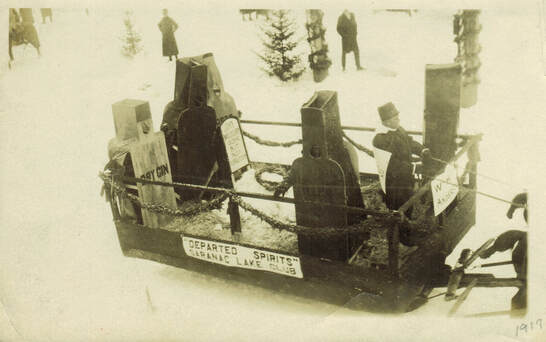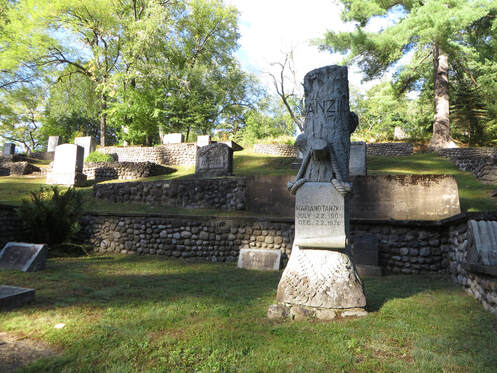PART ONE On January 29, 1919, the government enacted the Eighteenth Amendment, prohibiting the transportation and sale of alcoholic beverages. This act created a lucrative, new, and illegal enterprise for the North Country. Saranac Lake, with its maze of back roads and its close proximity to the Canadian border, soon found itself playing a key role in the bootlegging game. The Volstead Act changed the lives of many Saranac Lakers, and was instrumental in ending some prematurely. Saranac Lake's reputation as a center for the treatment of tuberculosis was growing, and its popularity as a tourist destination was already well established, but there were still many residents with thin wallets. The average annual wage for Americans in 1919 was $2,000, but most residents of this area earned far less. Prohibition would provide an opportunity to improve the cash flow for many locals. While the bulk of the imported booze was destined for Albany, New York City, and other large cities, speakeasies were numerous in Saranac Lake, and they were well stocked with Canadian booze. Locals, tourists, TB patients, and gangsters like Legs Diamond intermingled. It was the beginning of the Roaring Twenties, and it was party time! Men who were normally law-abiding citizens were drawn into this dangerous occupation in the hopes of making some quick cash. Area lawmen were soon pitted against a steady stream of fast-driving local runners. Stories have been passed down about the exploits of local bootleggers. Almost every family had at least one member in the business. Bert LaFountain, a local bootlegging virtuoso, had a song called, "Bert LaFountain's Packard” written about him. A street in Gabriels bears his name. In spite of his occupation, Bert lived a long life and died of natural causes. One local bootlegger, however, is virtually forgotten, in spite of the fact that he is the subject of a pair of mysteries that have remained unsolved for over seven decades. Pietro "Pete" Tanzini and his five brothers had come to the United States from Italy in the early 1900s. Eventually they came to Saranac Lake, where they operated a construction company specializing in first class masonry. The brothers produced some beautiful stone work in Saranac Lake, including the early brick streets, which they laid around 1916. The brick was eventually covered with asphalt, but patches of the Tanzini brothers’ work occasionally show through the asphalt around town.
Four of Pete's brothers later settled in Binghamton. One brother, Jack, stayed in Saranac Lake and was associated with Rocco and Jimmie's American-Italian Garden Restaurant at 104 Broadway, which was frequently busted for selling illegal beverages. Pete decided to become a more active participant in the illegal booze trade. Pete Tanzini was not only an expert stone mason; he was also an adept race car driver. He would utilize both of these skills in his bootlegging career. Because of his uncanny knack of avoiding their traps and disappearing quickly from sight, Pete became known by law enforcement agencies as the "Will O' The Wisp.” Pete's name was destined to become linked to North Country bootlegging and to the most perplexing unsolved mystery in the North Country. Stay tuned next week for more about the mystery of Pete Tanzini!
2 Comments
9/9/2020 11:54:04 am
Very interesting. I had no idea. Amazing the adventures that took place in our little town. Very well written.
Reply
Mato Ray
3/28/2022 08:47:09 am
Reply
Your comment will be posted after it is approved.
Leave a Reply. |
About us
Stay up to date on all the news and happenings from Historic Saranac Lake at the Saranac Laboratory Museum! Archives
August 2022
Categories
All
|
Historic Saranac Lake at the Saranac Laboratory Museum
89 Church Street, Suite 2, Saranac Lake, New York 12983
(518) 891-4606 - [email protected]
89 Church Street, Suite 2, Saranac Lake, New York 12983
(518) 891-4606 - [email protected]

Historic Saranac Lake is funded in part by the New York State Council on the Arts with the support of the Office of the Governor and the New York State Legislature,
and an Essex County Arts Council Cultural Assistance Program Grant supported by the Essex County Board of Supervisors.
and an Essex County Arts Council Cultural Assistance Program Grant supported by the Essex County Board of Supervisors.
© 2023 Historic Saranac Lake. All Rights Reserved. Historic photographs from Historic Saranac Lake Collection, unless otherwise noted. Copy and reuse restrictions apply.



 RSS Feed
RSS Feed